|
Circus maurus (Black
harrier)
Witkruisvleivalk, Witkruispaddavreter [Afrikaans]; Zwarte
kiekendief [Dutch]; Busard maure [French]; Mohrenweihe [German];
Tartaranhão-preto [Portuguese]
Life
> Eukaryotes >
Opisthokonta
> Metazoa (animals) >
Bilateria >
Deuterostomia > Chordata >
Craniata > Vertebrata (vertebrates) > Gnathostomata (jawed
vertebrates) > Teleostomi (teleost fish) > Osteichthyes (bony fish) > Class:
Sarcopterygii (lobe-finned
fish) > Stegocephalia (terrestrial
vertebrates) > Tetrapoda
(four-legged vertebrates) > Reptiliomorpha > Amniota >
Reptilia (reptiles) >
Romeriida > Diapsida > Archosauromorpha > Archosauria >
Dinosauria
(dinosaurs) > Saurischia > Theropoda (bipedal predatory dinosaurs) >
Coelurosauria > Maniraptora > Aves
(birds) > Order: Falconiformes
> Family: Accipitridae
> Genus: Circus
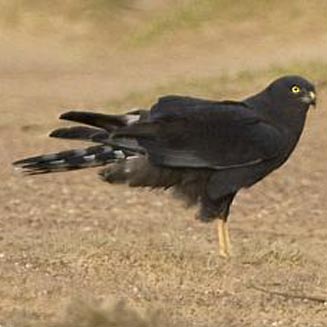 |
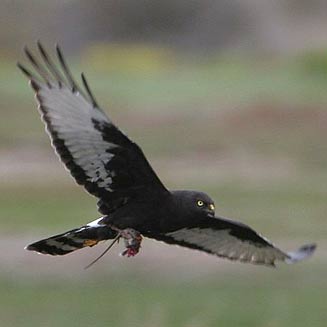 |
|
Black harrier adult, Klipbokkop Mountain Lodge, South Africa. [photo
Trevor Hardaker ©] |
Black harrier adult with rodent, West Coast National Park, South Africa. [photo Trevor Hardaker ©] |
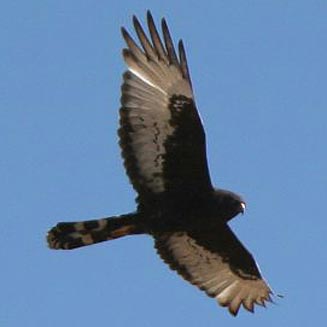 |
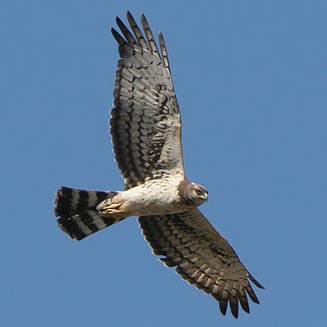 |
| Black harrier adult, Stompneusbaai,
South Africa. [photo Trevor Hardaker ©] |
Black harrier juvenile, West Coast National Park,
South Africa. [photo Trevor Hardaker ©] |
Distribution and habitat
Endemic to southern Africa, with the bulk of its population
occurring in South Africa and Lesotho; it is more scarce in south-western Botswana and
Namibia. It generally prefers fynbos in the Western Cape, especially strandveld
and mountain fynbos, while elsewhere it favours Karoo scrub, cultivated land and
high-altitude grassland.
|
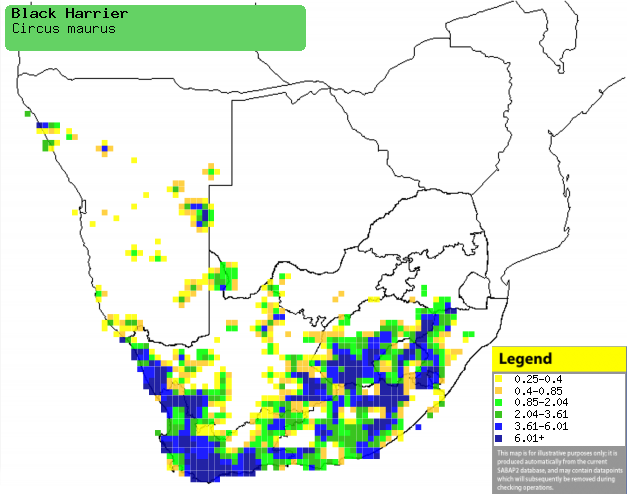 |
|
Distribution of Black harrier in southern Africa,
based on statistical smoothing of the records from first SA Bird Atlas
Project (©
Animal Demography unit, University of
Cape Town; smoothing by Birgit Erni and Francesca Little). Colours range
from dark blue (most common) through to yellow (least common).
See here for the latest distribution
from the SABAP2. |
Movements and migrations
Largely resident, although it tends to head
north and east from the Western Cape in winter.
Food
It mainly eats mice and birds, doing most of its hunting on
blustery days. It flies close to the ground, then
speedily drops onto its prey, often giving chase on the ground before finishing
the animal off. The following food items have been recorded
in its diet:
- birds
- rodents
- reptiles
- amphibians
- insects
- carrion
Breeding
- Typically a monogamous solitary nester, although a single male may mate
with multiple females (a practice known as polygyny). It occasionally forms loose colonies, with
nests spaced about 50-100m apart.
- Males vigorously defend their territory:
in one case, a male locked its talons with another male and they cart-wheeled to
the ground, after which they continued to fight. A few weeks later, one of
them was found dead from head wounds sustained from the fight.
- The male often
displays over a potential display site, flying up and down in a U-shaped
pattern, calling at the top of each undulation; this acts as both
a territorial and a courtship display. Once a female starts following him,
he finishes off with a spectacular looping flight close to the ground,
before descending to the potential nest site.
- The nest is a small platform of stems, grass and small twigs, typically
placed on or near the ground in dense marsh grass tufts or near fynbos
bushes and sedges. It especially favours nest sites alongside a small stream.
- Egg-laying season is from June-November, peaking in September.
- It lays 1-5, usually 3 eggs, which are solely incubated by the female
for roughly 34 days, while the male regularly feeds her at the nest.
- The chicks are cared for intensely by the female for the first few weeks
of their lives, feeding them with food provisioned by the male. At four
weeks old, the chicks start to hide in the vegetation surrounding the nest,
leaving completely at about 36-41 days old and becoming fully independent at
least two weeks later.
Threats
Globally Vulnerable, Endangered in Namibia
and Near-threatened in South Africa. Outside of protected areas it is
largely reliant on the remnants of natural vegetation in agricultural land.
References
-
Hockey PAR, Dean WRJ and Ryan PG 2005. Roberts
- Birds of southern Africa, VIIth ed. The Trustees of the John Voelcker
Bird Book Fund, Cape Town.
|
